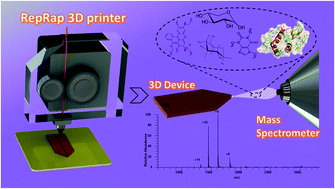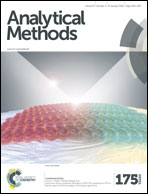3D printing of microfluidic devices for paper-assisted direct spray ionization mass spectrometry†
Abstract
This study describes the use of a 3D printer to fabricate microfluidic devices for direct spray ionization mass spectrometry (DS-MS) assisted by paper tips. The layout of the proposed devices was designed in a three-dimensional model through a computer-aided design system and printed by a fused deposition modeling method using a thermoplastic filament composed of acrylonitrile butadiene styrene deposited layer by layer. The smallest channel width was 400 μm to ensure 3D printing uniformity without any obstruction. For DS-MS studies, microfluidic channels consisted of a single channel connected to a sample reservoir (3 mm diameter). The printed channel was 3 cm long, 500 μm wide and 500 μm deep. Paper tips (0.5 cm long × ca. 0.5 mm wide) were manually cut and inserted into the extremity of the printed channel to facilitate the spray formation. The spray was promoted by the application of 4 kV at the sample reservoir containing 0.1% formic acid prepared in methanol. This organic medium selected for MS experiments has demonstrated great compatibility with the polymeric material employed to create microfluidic chips. 3D printed devices were kept at a distance of 3 mm from the MS entrance. Using glucose solution as the model, the formed spray by the proposed microfluidic device was extremely stable in comparison to traditional paper spray ionization devices for at least 10 min. The analytical feasibility of printed devices for DS-MS was successfully demonstrated by qualitative analysis of ballpoint pen inks, caffeine, xylose and lysozyme. The 3D printer has allowed the fabrication of printed devices at a very low cost ($0.05) within 20 min. Furthermore, 3D printed devices have exhibited significant repeatability and reproducibility, making their reuse possible. Based on the performance of the proposed devices, we believe they can be used in a broad range of bioanalytical applications.

- This article is part of the themed collections: Analytical Chemistry in South America and Microfluidics Research 2015-2016


 Please wait while we load your content...
Please wait while we load your content...